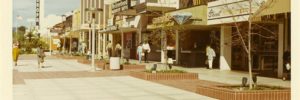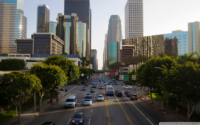
April 28, 2020
Los Angeles: 1985 and Today
On the Anniversary of ITDP’s 35th Year, Transport Matters will be publishing a series of articles about cities that ITDP has worked in, comparing them from 1985 and today. The article in full can be found in the Sustainable Transport Magazine. Read previous articles about Buenos Aires here, Chennai here, Rio de Janeiro here, Dar es Salaam here, Mexico City here, Guangzhou here, Jakarta here and London here.
In 1985, Los Angeles created the “911” emergency system, replicated both nationally and internationally as a model for emergency response. It was also the year of the city’s first no-smoking ordinance, which would grow to a bar and restaurant ban a decade later, and then grow further to inspire the country and world to tackle this public health issue. Despite leading the way on these and other innovations, LA was falling far behind on another: in 1985, the city had exactly zero kilometers of dedicated mass rapid transit.
Los Angeles Before
Click below photos to enlarge
There is, perhaps, no city more associated with the car-oriented lifestyle than Los Angeles. The most populous city in California, the most populous American state, LA’s famous gridlock costs the average Angeleno 92 extra hours a year. Most of LA’s driving happens on multi-lane highways and freeways, like the famous and recently expanded 405, that span nearly every part of this sprawling city, and cars remain the primary mode of transport. Today, however, public transport is a priority for the city and the state, as they deal with the fallout of climate change, poor air quality, and a housing crisis that demands attention. Los Angeles today has about 200 kilometers of light rail, a metro, and extensive bus system, which includes Los Angeles County’s NextGen bus network redesign program to increase bus frequency. Buses carry the majority of the nearly 40 million trips per month taken on transit, making for a transit mode share of 9 percent. However, bus ridership has decreased in recent years as more people are buying cars, service quality has declined, and on demand taxi services proliferate throughout the region.
Los Angeles Today
Click below photos to enlarge
LA’s list of challenges is long, and includes everything from parking reform, to changing laws to increase density and encourage transit-oriented development. Still, progress is being made. In 2008 voters supported a ballot measure, for a sales tax to fund public transportation. In 2019, the city passed an increase to this tax, and made it permanent. This public support, along with the strong political will of both the city and state, give LA a real chance for a serious transformation.
Los Angeles in Numbers
Jakarta has grown most in population, but so has its rapid transit which did not exist in 1985. To study cities and their growth, various metrics were employed to compare global cities. Some statistics included population, built-up area, and density. Kilometers of rapid transit were measured by including those that meet the definition of BRT basics in the BRT Standard. Additionally, RTR was studied to understand how the population is served by transit. Rapid Transit to Resident Ratio (RTR) is an important metric that compares the population with the length of rapid transit lines – this number shows how well a population is served by rapid transit. In Jakarta, population more than doubled, but kilometers of rapid transit, over 200 km is not enough to increase RTR significantly. Still, Transjakarta BRT has provided Jakarta with a much needed public transit. In the next 35 years, many more changes will come to Jakarta. With hope, the successes of Transjakarta can be replicated and increased.


















